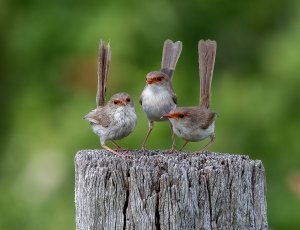You are here
Home ›What's chasing Fairy-wrens from our urban greenspaces?
Birds in Backyards recently co-supervised Genevieve Heggarty as she undertook a research project to tackle the question of what determines whether small birds, like Superb Fairy-wrens, can survive in urban areas. Genevieve shares her findings here.
Superb Fairy-wrens were once one of the most common birds found in Sydney. Unfortunately, over the last few decades, we have noticed a substantial decline in their numbers. There is a strong desire from the community to get these birds back into our backyards. As such, this charismatic Australian icon is often at the forefront of urban restoration programs to provide suitable shrubby habitat. However, there is still a lot we don’t know about this iconic species and how they are responding to the urban landscape.
Over the past eight months, I have been researching Superb Fairy-wrens for my honours project at the University of Sydney, partnering with BirdLife Australia. We aimed to understand what environmental and biotic factors are influencing the presence and abundance of Superb Fairy-wrens in Sydney’s urban greenspaces, beyond local habitat structure.
I conducted surveys in over 25 greenspaces in Sydney’s metropolitan area. We selected a range of greenspaces that had high shrub cover and could, in theory, support a Fairy-wren population. It was important to capture the differences between greenspaces with and without Superb Fairy-wrens present. In addition to conducting habitat surveys and local bird surveys, we set out 108 wildlife camera traps to survey the presence of introduced predators, including foxes, rats, and free-roaming cats. Finally, the broader landscape connectivity surrounding the greenspace was measured using spatial geographic tools.
Here are our main findings:
Superb Fairy-wren habitat also supports other small birds. Greenspaces with superb fairy-wrens significantly supported greater species diversity, in particular, other small birds facing population declines such as the Red-browed Finch, Willie Wagtail, and Silvereye.
Noisy Miners pose a significant challenge. Noisy Miners were the biggest limiting factor when it came to superb fairy-wren presence and abundance. Noisy Miners are known to aggressively exclude smaller birds from habitat.
Introduced predators are widespread. The results from the camera traps revealed that introduced predators, foxes, black rats, and free-roaming cats were in high numbers in almost all greenspaces over Sydney, even in our inner-city parks.
Superb Fairy-wren restoration requires more than local habitat structure. Most importantly we found no significant differences in the vegetation between sites with and without superb fairy-wrens. This demonstrates that despite the availability of suitable habitat, other factors such as species interactions and broader landscape context all impact the ability of this species to persist in a greenspace.
The findings suggest that a holistic approach is required. While local restoration efforts are crucial, we must also consider how the species can move through the broader urban landscape. The Superb Fairy-wren is a weak flyer, relying on small ‘stepping stones’ for dispersal, for which backyards and railway lines may be important. Secondly, it’s important to consider other species interactions when building Superb Fairy-wren habitat. Importantly, discouraging the presence of the aggressive Noisy Miner by planting a range of native shrubs that do not supply them with excess nectar. Lastly, introduced predators are pervasive across the landscape, and they may have an impact on the long-term survival of the Superb Fairy-wren in our urban areas. Keeping your cat indoors is an essential step in protecting these precious birds.
In conclusion, the journey to revive Sydney's Superb Fairy-wren population requires a collective effort, from local greenspace restoration to landscape-level conservation. By understanding the challenges these birds face and implementing these findings into our restoration programs, we can ensure that the song of the Superb Fairy-wren will continue to echo throughout our urban greenspaces for generations to come.
Check out Instagram @BirdsinBackyards for some photos from the wildlife cameras.
See our suggested garden guide for small birds at Bird Friendly Gardening
Banner image by Susan Chisholm









